Mathematical Beliefs Held by Costa Rican Pre-Service Teachers and Teacher Educators
Abstract
1. Introduction
2. Theoretical Framework
2.1. Understanding the Concept of Belief
2.2. Beliefs Areas of Mathematics Teachers
2.3. Teacher Profiles According to the Beliefs Held
2.4. Research Questions
- What are the beliefs of Costa Rican pre-service teachers and teacher educators about the nature of mathematics, mathematics teaching and learning, and mathematical abilities?
- What factors are related to the beliefs of Costa Rican pre-service teachers?
- (a)
- How are school performance and the beliefs of pre-service teachers related?
- (b)
- How are TEPs and the beliefs of pre-service teachers related?
- (c)
- How are the performance on the TEDS-M test and the beliefs of pre-service teachers related?
- What factors are related to the beliefs of Costa Rican teacher educators?
- (a)
- How are academic background and the beliefs of teacher educators related?
- (b)
- How are years of experience and the beliefs of teacher educators related?
- (c)
- How are special preparation for teaching and the beliefs of teacher educators related?
3. Materials and Methods
3.1. Mathematics Teacher Education in Costa Rica
3.2. Participants
3.3. Data Collection
3.4. Analysis
4. Results
4.1. Nature of Mathematics
4.2. Teaching and Learning Mathematics
4.3. Mathematical Abilities
4.4. Relations between Pre-Service Teachers’ Beliefs and Their Background and Performance in the Mathematical Knowledge Test
4.5. Relations between Teacher Educators’ Beliefs and Their Academic Background, Years of Experience, and Special Preparation for Teaching
5. Discussion
5.1. Descriptive Analysis of Pre-Service Teachers and Teacher Educators Beliefs
5.2. Variables Associated with Participant Beliefs
6. Conclusions
Author Contributions
Funding
Institutional Review Board Statement
Informed Consent Statement
Data Availability Statement
Acknowledgments
Conflicts of Interest
References
- Ministerio de Educación Pública. Programas de Estudio: Matemáticas. Available online: https://www.mep.go.cr/programa-estudio/matematicas (accessed on 29 December 2020).
- Programa Estado de la Nación. Resumen Séptimo Informe Estado de la Educación; Masterlitto: San José, Costa Rica, 2019. [Google Scholar]
- Nespor, J. The role of beliefs in the practice of teaching. J. Curric. Stud. 1987, 19, 317–328. [Google Scholar] [CrossRef]
- Pajares, M.F. Teachers’ beliefs and educational research: Cleaning up a messy construct. Rev. Educ. Res. 1992, 62, 307–332. [Google Scholar] [CrossRef]
- Speer, N. Issues of methods and theory in the study of mathematics teachers’ professed and attributed beliefs. Educ. Stud. Math. 2005, 58, 361–391. [Google Scholar] [CrossRef]
- Boz, N. Turkish pre-service mathematics teachers’ beliefs about mathematics teaching. Aust. J. Teach. Educ. 2008, 33, 66–80. [Google Scholar] [CrossRef]
- Voss, T.; Kleickmann, T.; Kunter, M.; Hachfeld, A. Mathematics teachers’ beliefs. In Cognitive Activation in the Mathematics Classroom and Professional Competence of Teachers. Mathematics Teacher Education; Kunter, M., Baumert, J., Blum, W., Klusmann, U., Krauss, S., Neubrand, M., Eds.; Springer: Boston, MA, USA, 2013; Volume 8, pp. 249–271. [Google Scholar] [CrossRef]
- Barkatsas, A.T.; Malone, J.A. Typology of mathematics teachers’ beliefs about teaching and learning mathematics and instructional practices. Math. Educ. Res. J. 2005, 17, 69–90. [Google Scholar] [CrossRef]
- Tang, S.J.; Hsieh, F.J. The cultural notion of teacher education: Future lower secondary teachers’ beliefs on the nature of mathematics, the learning of mathematics and mathematics achievement. In International Perspectives on Teacher Knowledge, Beliefs and Opportunities to Learn; Blömeke, S., Hsieh, F.J., Kaiser, G., Schmidt, W., Eds.; Springer: Dordrecht, The Netherlands, 2014; pp. 231–253. [Google Scholar] [CrossRef]
- Tatto, M.T.; Peck, R.; Schwille, J.; Bankov, K.; Senk, S.L.; Rodriguez, M.; Ingvarson, L.; Reckase, M.; Rowley, G. Policy, Practice, and Readiness to Teach Primary and Secondary Mathematics in 17 Countries: Findings from the IEA Teacher Education and Development Study in Mathematics (TEDS-M); International Association for the Evaluation of Educational Achievement: Amsterdam, The Netherlands, 2012. [Google Scholar]
- Peterson, P.L.; Fennema, E.; Carpenter, T.P.; Loef, M. Teachers’ pedagogical content beliefs in mathematics. Cogn. Instr. 1989, 6, 1–40. [Google Scholar] [CrossRef]
- Staub, F.C.; Stern, E. The nature of teachers’ pedagogical content beliefs matters for students’ achievement gains: Quasi-experimental evidence from elementary mathematics. J. Educ. Psychol. 2002, 94, 344–355. [Google Scholar] [CrossRef]
- Stipek, D.J.; Givvin, K.B.; Salmon, J.M.; MacGyvers, V.L. Teachers’ beliefs and practices related to mathematics instruction. Teach. Teach. Educ. 2001, 17, 213–226. [Google Scholar] [CrossRef]
- Thompson, A.G. The relationship of teachers’ conceptions of mathematics and mathematics teaching to instructional practice. Educ. Stud. Math. 1984, 15, 105–127. [Google Scholar] [CrossRef]
- Raymond, A.M. Inconsistency between a beginning elementary school teacher’s mathematics beliefs and teaching practice. J. Res. Math. Educ. 1997, 28, 550–576. [Google Scholar] [CrossRef]
- Gamboa Araya, R.; Moreira Mora, T.E. Actitudes y creencias hacia las matemáticas: Un estudio comparativo entre estudiantes y profesores. Actual. Investig. Educ. 2017, 17, 514–559. [Google Scholar] [CrossRef]
- Mora, F.; Campos, H. Qué es matemática? Creencias y concepciones en la enseñanza media costarricense. Cuad. Investig. Form. Educ. Mat. 2008, 4, 71–81. [Google Scholar]
- Wang, T.Y.; Hsieh, F.J. The cultural notion of teacher education: Comparison of lower-secondary future teachers’ and teacher educators’ beliefs. In International Perspectives on Teacher Knowledge, Beliefs and Opportunities to Learn; Blömeke, S., Hsieh, F.J., Kaiser, G., Schmidt, W., Eds.; Springer: Dordrecht, The Netherlands, 2014; pp. 255–277. [Google Scholar] [CrossRef]
- Thompson, A.G. Teachers’ beliefs and conceptions: A synthesis of the research. In Handbook of Research in Mathematics Teaching and Learning; Grouws, D., Ed.; MacMillan: New York, NY, USA, 1992; pp. 127–146. [Google Scholar]
- Furinghetti, F.; Pehkonen, E. Rethinking characterizations of beliefs. In Beliefs: A Hidden Variable in Mathematics Education? Pehkonen, E., Törner, G., Leder, G.C., Eds.; Springer: Dordrecht, The Netherlands, 2002; Volume 31, pp. 39–57. [Google Scholar]
- Skott, J.; Mosvold, R.; Sakonidis, C. Classroom practice and teachers’ knowledge, beliefs, and identity. In Developing Research in Mathematics Education: Twenty Years of Communications, Cooperation, and Collaboration in Europe; Dreyfus, T., Artigue, M., Potari, D., Prediger, S., Ruthven, K., Eds.; Routledge: Oxon, UK, 2018; pp. 162–180. [Google Scholar]
- Sigel, I. A conceptual analysis of beliefs. In Parental Belief Systems: The Psychological Consequences for Children; Sigel, I.A., Ed.; Lawrence Erlbaum: Hillsdale, NJ, USA, 1985; Volume 1, pp. 345–371. [Google Scholar]
- Richardson, V. The role of attitudes and beliefs in learning to teach. In Handbook of Research on Teacher Education; Sikula, J., Ed.; MacMillan: New York, NY, USA, 1996; pp. 102–119. [Google Scholar]
- Schoenfeld, A.H. Learning to think mathematically: Problem solving, metacognition, and sense making in mathematics. In Handbook of Research on Mathematics Learning and Teaching; Grouws, D.A., Ed.; Macmillan: New York, NY, USA, 1992; pp. 334–370. [Google Scholar]
- Philipp, R.A. Mathematics teachers’ beliefs and affect. In Second Handbook of Research on Mathematics Teaching and Learning; Lester, F.K., Jr., Ed.; Information Age: Charlotte, NC, USA, 2007; pp. 257–315. [Google Scholar]
- Felbrich, A.; Kaiser, G.; Schmotz, C. The cultural dimension of beliefs: An investigation of future primary teachers’ epistemological beliefs concerning the nature of mathematics in 15 countries. ZDM Math. Educ. 2012, 44, 355–366. [Google Scholar] [CrossRef]
- Ponte, J.P. Teachers’ beliefs and conceptions as a fundamental topic in teacher education. In On Research in Teacher Education: From a Study of Teaching Practices to Issues in Teacher Education. Proceedings of the First Conference of the European Society for Research in Mathematics Education, Osnabrück, Germany, 27–30 August 1998; Krainer, K., Goffree, F., Berger, P., Eds.; Forschungsintitut für Mathematikdidaktik: Osnabrück, Germany, 1999; Volume 3, pp. 43–50. [Google Scholar]
- McLeod, D.B. Research on affect in mathematics education: A reconceptualization. In Handbook of Research on Mathematics Learning and Teaching; Grouws, D.A., Ed.; Macmillan: New York, NY, USA, 1992; pp. 575–596. [Google Scholar]
- Op’t Eynde, P.; De Corte, E.; Verschaffel, L. Framing students’ mathematics-related beliefs. In Beliefs: A Hidden Variable in Mathematics Education? Pehkonen, E., Törner, G., Leder, G.C., Eds.; Springer: Dordrecht, The Netherlands, 2002; Volume 31, pp. 13–37. [Google Scholar]
- Blömeke, S.; Kaiser, G. Theoretical framework, study design and main results of TEDS-M. In International Perspectives on Teacher Knowledge, Beliefs and Opportunities to Learn; Blömeke, S., Hsieh, F.J., Kaiser, G., Schmidt, W., Eds.; Springer: Dordrecht, The Netherlands, 2014; pp. 19–47. [Google Scholar] [CrossRef]
- Grigutsch, S.; Raatz, U.; Törner, G. Einstellungen gegenüber Mathematik bei Mathematiklehrern. J. Math-Didakt. 1998, 19, 3–45. [Google Scholar] [CrossRef]
- Alfaro, H.; Joutsenlahti, J. What skills and knowledge do university mathematics teacher education programs give future teachers in Costa Rica? Eur. J. Sci. Math. Educ. 2020, 8, 145–162. [Google Scholar]
- Tatto, M.T.; Schwille, J.; Senk, S.; Ingvarson, L.; Peck, R.; Rowley, G. Teacher Education and Development Study in Mathematics (TEDS-M): Policy, Practice, and Readiness to Teach Primary and Secondary Mathematics. Conceptual Framework; Teacher Education and Development International Study Center, College of Education, Michigan State University: East Lansing, MI, USA, 2008. [Google Scholar]
- Peker, M.; Ulu, M. The effect of pre-service mathematics teachers’ beliefs about mathematics teaching-learning on their mathematics teaching anxiety. Int. J. Instr. 2018, 11, 249–264. [Google Scholar] [CrossRef]
- Alfaro, A.L.; Alpízar, M.; Morales, Y.; Ramírez, M.; Salas, O. La formación inicial y continua de docentes de matemáticas en Costa Rica. Cuad. Investig. Form. Educ. Mat. 2013, 8, 131–179. [Google Scholar]
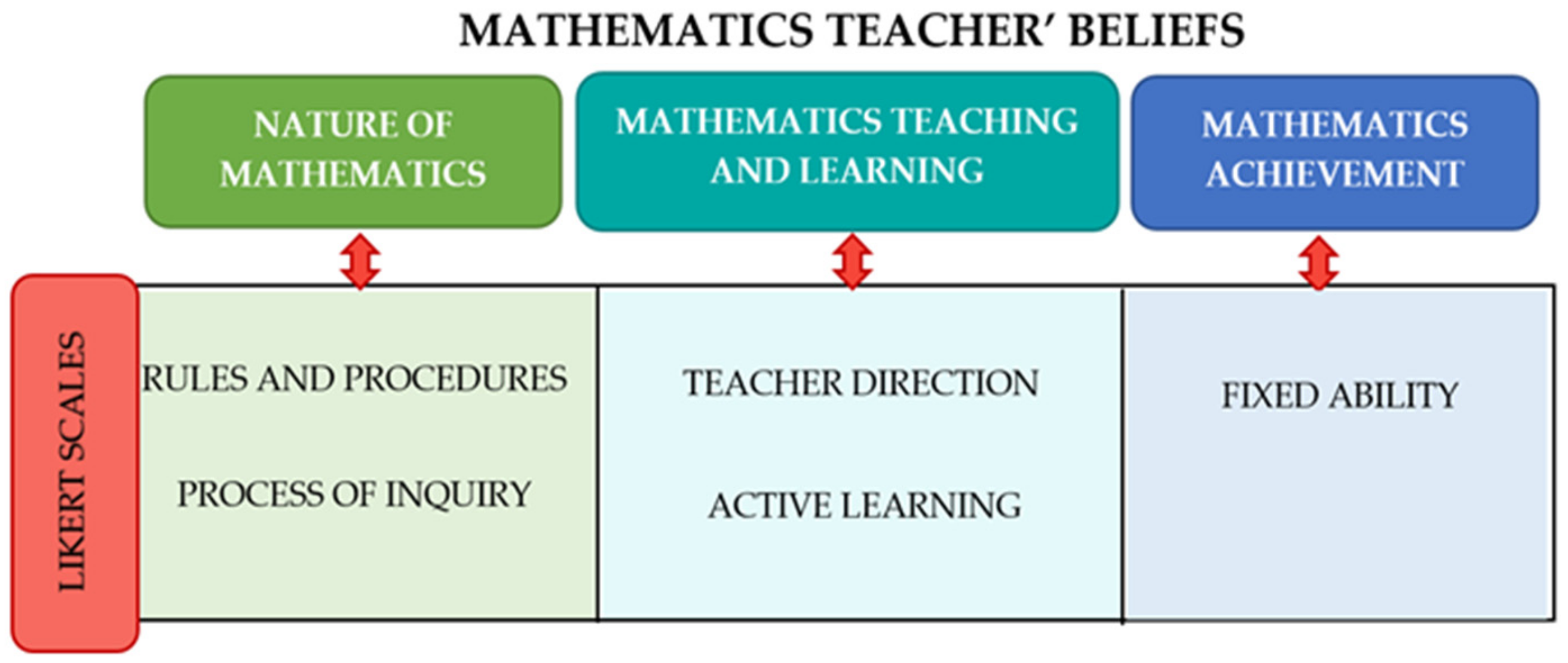
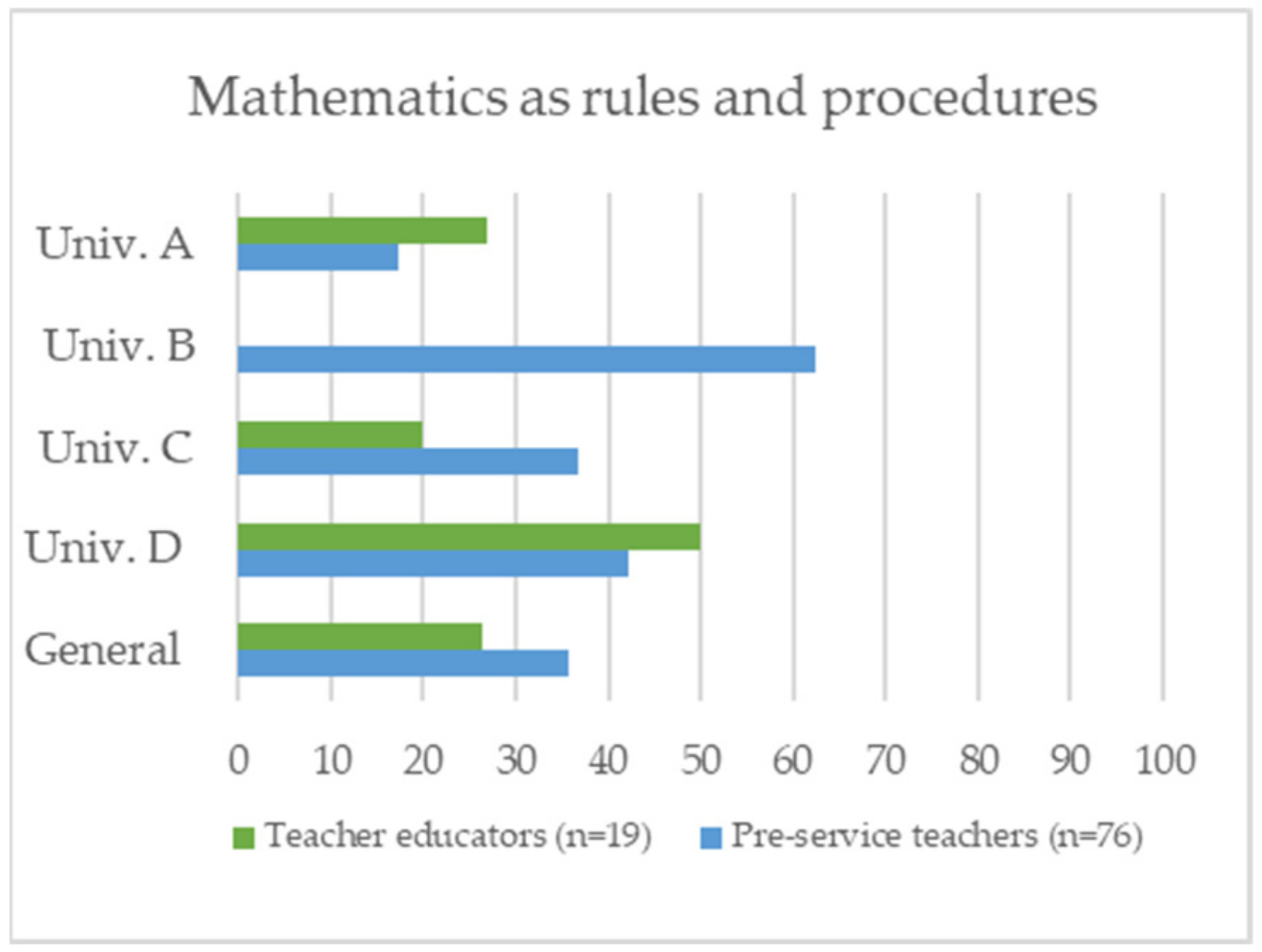
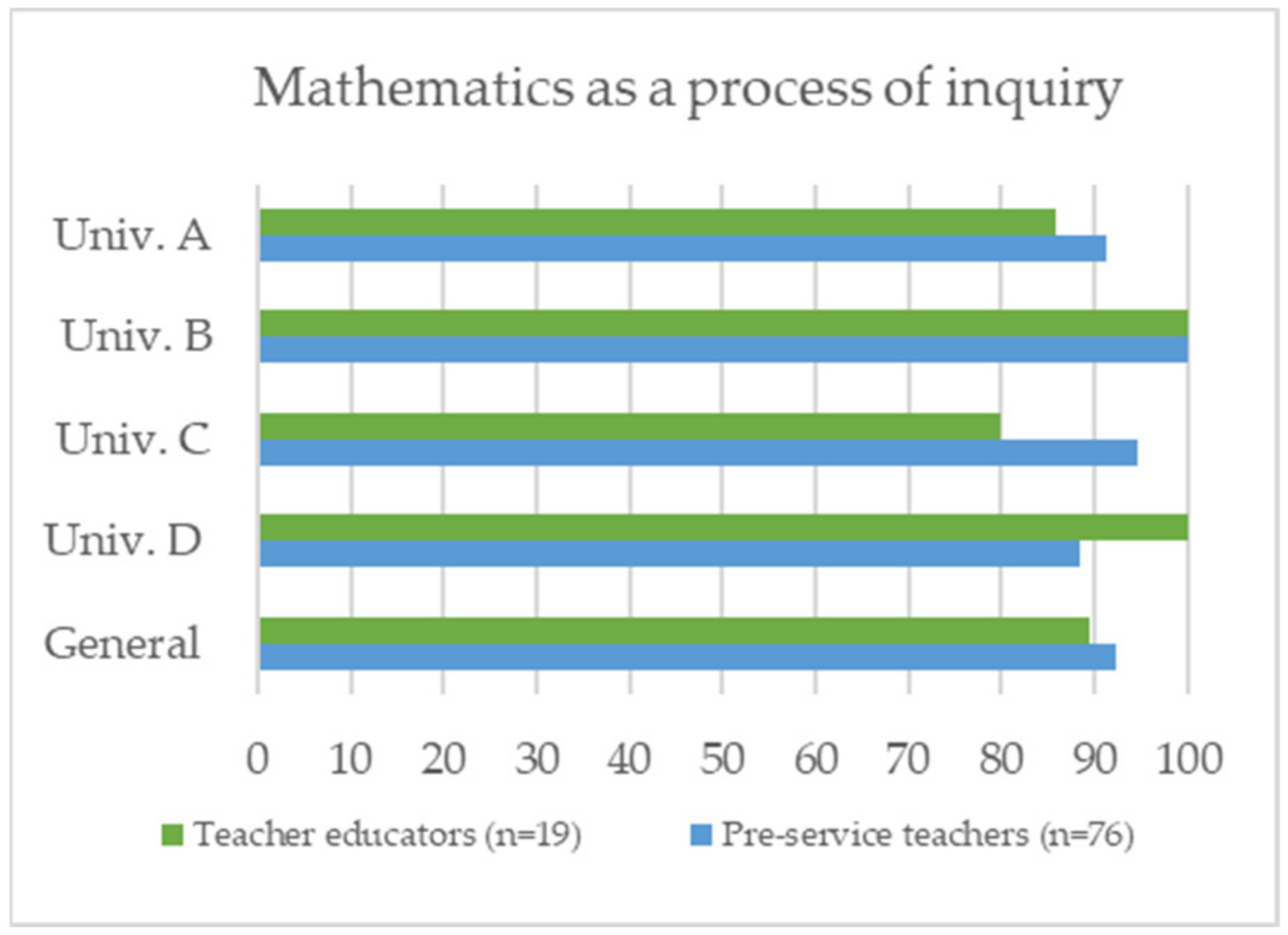
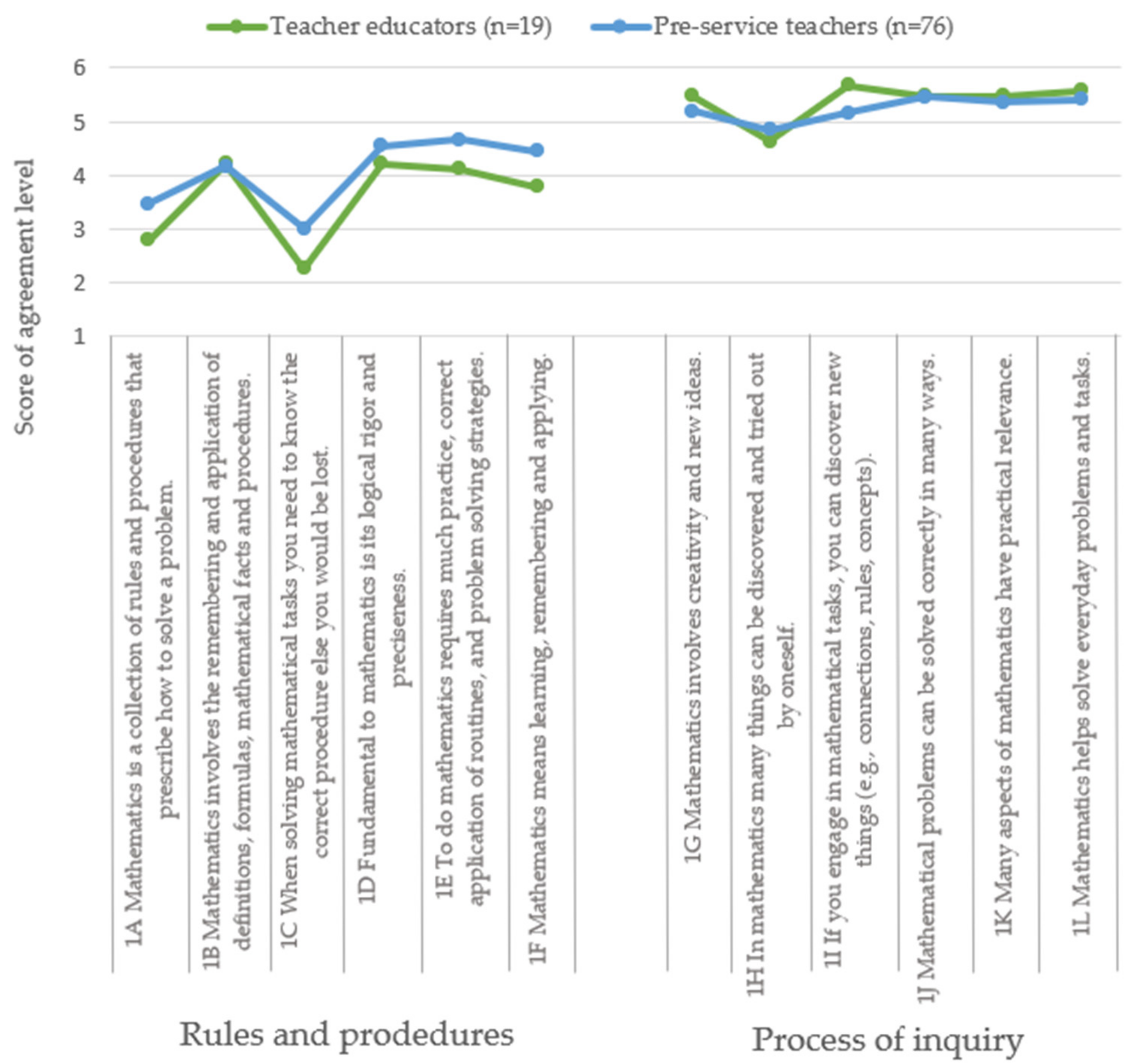
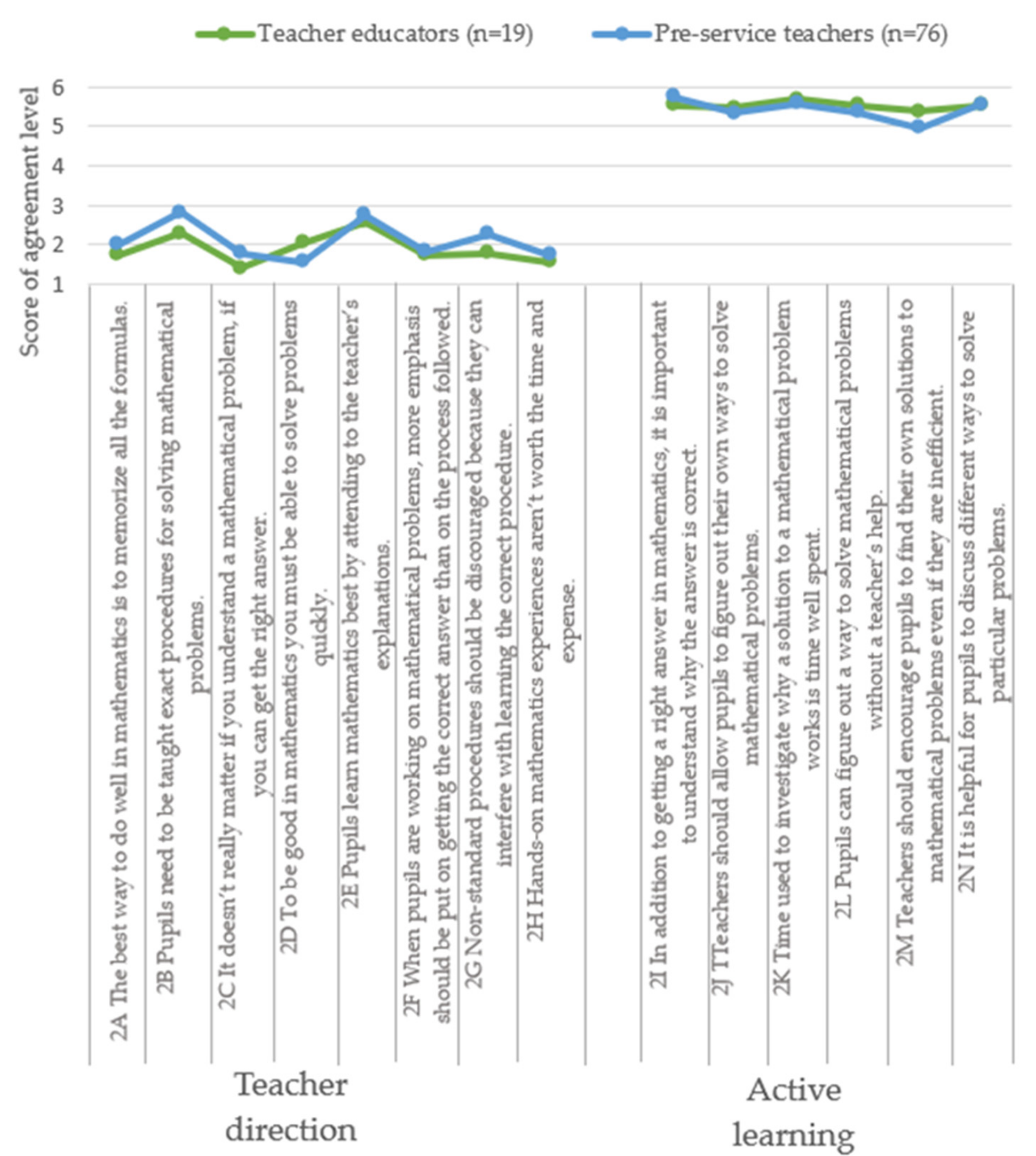
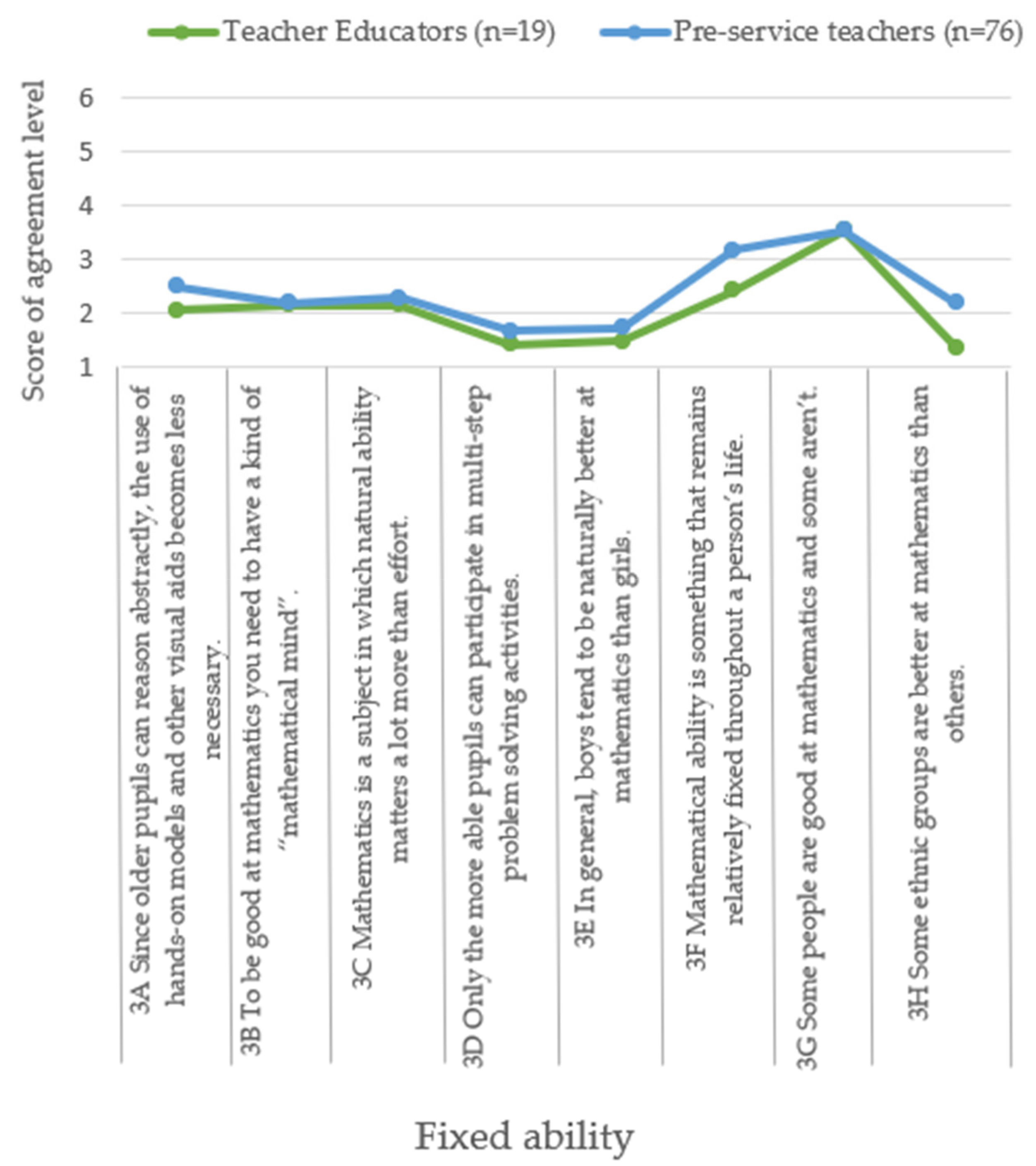
| University | Pre-Service Teachers | Teacher Educators |
|---|---|---|
| A | 23 | 7 |
| B | 8 | 3 |
| C | 19 | 5 |
| D | 26 | 4 |
| Total | 76 | 19 |
Publisher’s Note: MDPI stays neutral with regard to jurisdictional claims in published maps and institutional affiliations. |
© 2021 by the authors. Licensee MDPI, Basel, Switzerland. This article is an open access article distributed under the terms and conditions of the Creative Commons Attribution (CC BY) license (http://creativecommons.org/licenses/by/4.0/).
Share and Cite
Alfaro Víquez, H.; Joutsenlahti, J. Mathematical Beliefs Held by Costa Rican Pre-Service Teachers and Teacher Educators. Educ. Sci. 2021, 11, 70. https://doi.org/10.3390/educsci11020070
Alfaro Víquez H, Joutsenlahti J. Mathematical Beliefs Held by Costa Rican Pre-Service Teachers and Teacher Educators. Education Sciences. 2021; 11(2):70. https://doi.org/10.3390/educsci11020070
Chicago/Turabian StyleAlfaro Víquez, Helen, and Jorma Joutsenlahti. 2021. "Mathematical Beliefs Held by Costa Rican Pre-Service Teachers and Teacher Educators" Education Sciences 11, no. 2: 70. https://doi.org/10.3390/educsci11020070
APA StyleAlfaro Víquez, H., & Joutsenlahti, J. (2021). Mathematical Beliefs Held by Costa Rican Pre-Service Teachers and Teacher Educators. Education Sciences, 11(2), 70. https://doi.org/10.3390/educsci11020070






